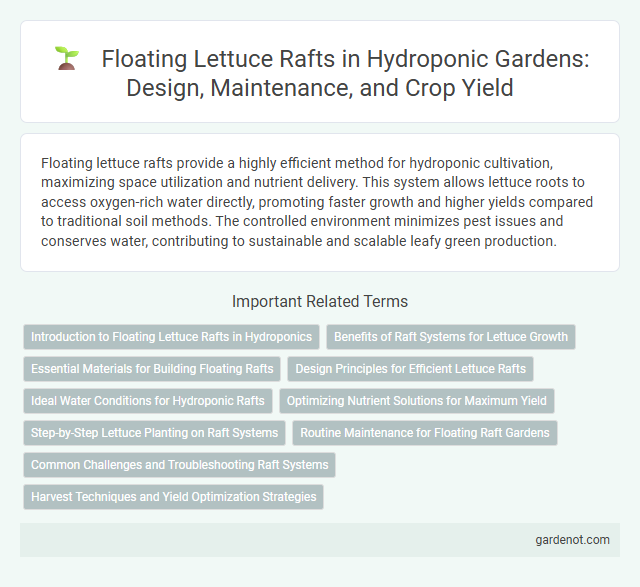Floating lettuce rafts provide a highly efficient method for hydroponic cultivation, maximizing space utilization and nutrient delivery. This system allows lettuce roots to access oxygen-rich water directly, promoting faster growth and higher yields compared to traditional soil methods. The controlled environment minimizes pest issues and conserves water, contributing to sustainable and scalable leafy green production.
Introduction to Floating Lettuce Rafts in Hydroponics
Floating lettuce rafts serve as an efficient growing medium in hydroponic systems, supporting lettuce plants on buoyant platforms that float atop nutrient-rich water solutions. This method optimizes oxygen and nutrient delivery directly to the roots, promoting faster growth and higher yields compared to traditional soil cultivation. Hydroponic floating rafts enhance space utilization and water conservation, making them ideal for urban agriculture and controlled environment farming.
Benefits of Raft Systems for Lettuce Growth
Floating lettuce raft systems create an ideal hydroponic environment by providing consistent access to nutrient-rich water, promoting faster growth and higher yields. These systems enhance oxygen availability to the roots, reducing disease risk and improving overall plant health. Their space-efficient design allows for scalable production, making them a preferred choice for commercial lettuce cultivation.
Essential Materials for Building Floating Rafts
Essential materials for building floating lettuce rafts include high-density polyethylene (HDPE) sheets for durable, water-resistant bases and expanded polystyrene foam for buoyancy and stability. Waterproof adhesives and UV-resistant coatings are critical to ensure longevity and maintain raft integrity in aquatic environments. Incorporating inert planting media like rockwool or coconut coir supports healthy root development and nutrient absorption for optimal hydroponic growth.
Design Principles for Efficient Lettuce Rafts
Floating lettuce rafts for hydroponic landscapes rely on lightweight, durable materials like expanded polystyrene foam to ensure buoyancy and stability. Optimal spacing between lettuce plants, typically 6 to 8 inches apart, promotes adequate nutrient absorption and prevents overcrowding. The raft design integrates perforations for root suspension, maximizing oxygen exposure and nutrient flow to enhance lettuce growth efficiency.
Ideal Water Conditions for Hydroponic Rafts
Maintaining ideal water conditions for hydroponic floating lettuce rafts requires precise control of pH levels between 5.5 and 6.5 to optimize nutrient uptake. Dissolved oxygen concentrations should be kept above 6 mg/L to promote healthy root respiration and prevent anaerobic conditions. Temperature stability between 18degC and 22degC ensures maximal growth rates and nutrient assimilation in hydroponic systems.
Optimizing Nutrient Solutions for Maximum Yield
Optimizing nutrient solutions in floating lettuce raft systems involves precise control of essential elements like nitrogen, phosphorus, and potassium at concentrations tailored to lettuce growth stages. Maintaining appropriate pH levels between 5.5 and 6.5 enhances nutrient uptake efficiency, while regular monitoring and adjustment of electrical conductivity (EC) around 1.5-2.0 mS/cm ensures balanced nutrient availability. Incorporating micronutrients such as iron, magnesium, and calcium supports healthy plant development and maximizes overall yield in hydroponic lettuce production.
Step-by-Step Lettuce Planting on Raft Systems
Prepare the floating lettuce raft by securely fitting polystyrene boards with evenly spaced planting holes for optimal root oxygenation. Gently place lettuce seedlings into net pots filled with inert media, ensuring roots extend through the holes into the nutrient solution below. Maintain constant nutrient circulation and monitor pH levels between 5.5 and 6.5 for ideal growth in hydroponic raft systems.
Routine Maintenance for Floating Raft Gardens
Routine maintenance of floating lettuce rafts in hydroponic landscapes involves regularly monitoring nutrient solution levels and pH balance to ensure optimal plant growth. Cleaning the rafts and removing algae buildup prevents blockages and promotes healthy oxygen flow to the roots. Periodic inspection of water pumps and aeration systems is essential to maintain consistent circulation and prevent root diseases in floating raft gardens.
Common Challenges and Troubleshooting Raft Systems
Floating lettuce raft systems frequently face issues such as nutrient imbalances, root rot, and algae overgrowth, which can hinder plant growth and reduce yields. Maintaining optimal pH levels between 5.5 and 6.5, ensuring adequate oxygenation through proper aeration, and regularly cleaning the raft and reservoir are essential steps to prevent these problems. Troubleshooting involves adjusting nutrient concentrations, improving water flow, and removing algae buildup to sustain healthy, vigorous lettuce production.
Harvest Techniques and Yield Optimization Strategies
Floating lettuce rafts leverage nutrient-rich water solutions to maximize growth rates and leaf quality, enabling multiple harvest cycles within a compact area. Precise control of pH and dissolved oxygen levels in the hydroponic reservoir enhances root development and reduces crop stress, directly improving yield consistency. Implementing staggered planting schedules and routine maintenance of raft buoyancy ensures uniform exposure to nutrients and light, optimizing overall production efficiency.
Floating lettuce raft Infographic

 gardenot.com
gardenot.com